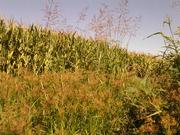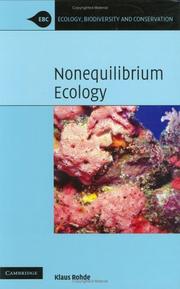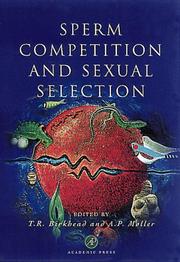| Listing 1 - 9 of 9 |
Sort by
|

ISBN: 0273084895 Year: 1982 Publisher: London Pitman
Abstract | Keywords | Export | Availability | Bookmark
 Loading...
Loading...Choose an application
- Reference Manager
- EndNote
- RefWorks (Direct export to RefWorks)
Coexistence. --- Competition (Biology) --- Competition (Biology).
Book
ISBN: 9780521887106 9781139051248 Year: 2013 Publisher: Cambridge Cambridge University Press
Abstract | Keywords | Export | Availability | Bookmark
 Loading...
Loading...Choose an application
- Reference Manager
- EndNote
- RefWorks (Direct export to RefWorks)
Book
ISBN: 0691084068 0691628904 0691611149 1400886147 9781400886142 0691081484 9780691081489 9780691084060 Year: 2017 Publisher: Princeton, NJ
Abstract | Keywords | Export | Availability | Bookmark
 Loading...
Loading...Choose an application
- Reference Manager
- EndNote
- RefWorks (Direct export to RefWorks)
Eric Pianka offers a synthesis of his life's work on the comparative ecology of lizard assemblages in the Great Basin. Mojave and Sonoran deserts of western North America, the Kalahari semi-desert of southern Africa, and the Great Victoria desert of Western Australia.Originally published in 1986.The Princeton Legacy Library uses the latest print-on-demand technology to again make available previously out-of-print books from the distinguished backlist of Princeton University Press. These editions preserve the original texts of these important books while presenting them in durable paperback and hardcover editions. The goal of the Princeton Legacy Library is to vastly increase access to the rich scholarly heritage found in the thousands of books published by Princeton University Press since its founding in 1905.
Lizards --- Desert animals --- Niche (Ecology) --- Biotic communities. --- Reptiles --- Herpetofauna --- Herpetozoa --- Herps --- Herptiles --- Reptilia --- Sauria --- Amniotes --- Vertebrates --- Herpetology --- Biocenoses --- Biocoenoses --- Biogeoecology --- Biological communities --- Biomes --- Biotic community ecology --- Communities, Biotic --- Community ecology, Biotic --- Ecological communities --- Ecosystems --- Natural communities --- Ecology --- Population biology --- Microhabitat --- Biotic communities --- Competition (Biology) --- Habitat (Ecology) --- Desert fauna --- Arid regions animals --- Desert biology --- Lacertilia --- Lacertilian reptiles --- Lacertilians --- Squamata --- Ecology.

ISBN: 9780511542152 9780521854344 9780521674553 0511137559 9780511137556 0511133979 9780511133978 0511542151 9780511135385 0511135386 0521854342 0521674557 1107155037 9781107155039 1280431768 9781280431760 9786610431762 6610431760 0511183682 9780511183683 0511201753 9780511201752 0511311869 9780511311864 Year: 2005 Publisher: Cambridge, UK New York Cambridge University Press
Abstract | Keywords | Export | Availability | Bookmark
 Loading...
Loading...Choose an application
- Reference Manager
- EndNote
- RefWorks (Direct export to RefWorks)
Ecology has long been shaped by ideas that stress the sharing of resources and the competition for those resources, and by the assumption that populations and communities typically exist under equilibrium conditions in habitats saturated with both individuals and species. However, much evidence contradicts these assumptions and it is likely that nonequilibrium is much more widespread than might be expected. This book is unique in focusing on nonequilibrium aspects of ecology, providing evidence for nonequilibrium and equilibrium in populations (and metapopulations), in extant communities and in ecological systems over evolutionary time, including nonequilibrium due to recent and present mass extinctions. The assumption that competition is of overriding importance is central to equilibrium ecology, and much space is devoted to its discussion. As communities of some taxa appear to be shaped more by competition than others, an attempt is made to find an explanation for these differences.
Ecology. --- Competition (Biology) --- Biotic competition --- Ecological competition --- Interspecific competition --- Intraspecific competition --- Species competition --- Struggle for survival (Biology) --- Survival, Struggle for (Biology) --- Population biology --- Species --- Balance of nature --- Biology --- Bionomics --- Ecological processes --- Ecological science --- Ecological sciences --- Environment --- Environmental biology --- Oecology --- Environmental sciences --- Ecology
Book
ISBN: 128059456X 9786613624390 0191628018 9780191628016 9780199587100 0199587108 9780199587117 0199587116 0191628026 Year: 2012 Publisher: Oxford University press
Abstract | Keywords | Export | Availability | Bookmark
 Loading...
Loading...Choose an application
- Reference Manager
- EndNote
- RefWorks (Direct export to RefWorks)
The origin of biological diversity, via the formation of new species, can be inextricably linked to adaptation to the ecological environment. Specifically, ecological processes are central to the formation of new species when barriers to gene flow (reproductive isolation) evolve between populations as a result of ecologically-based divergent natural selection. This process of 'ecological speciation' has seen a large body of particularly focused research in the last 10-15 years, anda review and synthesis of the theoretical and empirical literature is now timely.The book begins by clarifying wha
Evolution. --- Species. --- Symbiogenesis. --- Biodiversity --- Evolution (Biology) --- Isolating mechanisms --- Niche (Ecology) --- Species --- Speciation (Biology) --- Biology --- Genetics --- Hybridization --- Organisms --- Microhabitat --- Biotic communities --- Competition (Biology) --- Ecology --- Habitat (Ecology) --- Isolation, Biotic --- Isolation mechanisms --- Reproductive isolation mechanisms --- Reproduction --- Animal evolution --- Animals --- Biological evolution --- Darwinism --- Evolutionary biology --- Evolutionary science --- Origin of species --- Evolution --- Biological fitness --- Homoplasy --- Natural selection --- Phylogeny --- Biological diversification --- Biological diversity --- Biotic diversity --- Diversification, Biological --- Diversity, Biological --- Biocomplexity --- Ecological heterogeneity --- Numbers of species --- Isolating mechanisms. --- Biodiversity.

ISBN: 0691044384 0691044376 9780691044378 1400847265 1299051545 9781400847266 9780691044385 9781299051546 9780691044385 Year: 2003 Publisher: Princeton, N.J. Princeton University Press
Abstract | Keywords | Export | Availability | Bookmark
 Loading...
Loading...Choose an application
- Reference Manager
- EndNote
- RefWorks (Direct export to RefWorks)
The seemingly innocent observation that the activities of organisms bring about changes in environments is so obvious that it seems an unlikely focus for a new line of thinking about evolution. Yet niche construction--as this process of organism-driven environmental modification is known--has hidden complexities. By transforming biotic and abiotic sources of natural selection in external environments, niche construction generates feedback in evolution on a scale hitherto underestimated--and in a manner that transforms the evolutionary dynamic. It also plays a critical role in ecology, supporting ecosystem engineering and influencing the flow of energy and nutrients through ecosystems. Despite this, niche construction has been given short shrift in theoretical biology, in part because it cannot be fully understood within the framework of standard evolutionary theory. Wedding evolution and ecology, this book extends evolutionary theory by formally including niche construction and ecological inheritance as additional evolutionary processes. The authors support their historic move with empirical data, theoretical population genetics, and conceptual models. They also describe new research methods capable of testing the theory. They demonstrate how their theory can resolve long-standing problems in ecology, particularly by advancing the sorely needed synthesis of ecology and evolution, and how it offers an evolutionary basis for the human sciences. Already hailed as a pioneering work by some of the world's most influential biologists, this is a rare, potentially field-changing contribution to the biological sciences.
Evolution. Phylogeny --- Human ecology. Social biology --- Niche (Ecology) --- Evolution (Biology) --- Human ecology. --- Niche écologique --- Evolution (Biologie) --- Ecologie humaine --- 575.829 --- 574.2 --- Other factors of evolution --- Organisms and environment. Habitat. Preferendum --- 574.2 Organisms and environment. Habitat. Preferendum --- 575.829 Other factors of evolution --- Niche écologique --- Ecology --- Environment, Human --- Human beings --- Human environment --- Animal evolution --- Animals --- Biological evolution --- Darwinism --- Evolutionary biology --- Evolutionary science --- Origin of species --- Microhabitat --- Social aspects --- Evolution --- Ecological engineering --- Human geography --- Nature --- Biology --- Biological fitness --- Homoplasy --- Natural selection --- Phylogeny --- Biotic communities --- Competition (Biology) --- Habitat (Ecology) --- Effect of environment on --- Effect of human beings on --- Human ecology

ISBN: 0121005437 9780121005436 9780080541594 0080541593 1281054070 9781281054074 9786611054076 Year: 1998 Publisher: San Diego Academic Press
Abstract | Keywords | Export | Availability | Bookmark
 Loading...
Loading...Choose an application
- Reference Manager
- EndNote
- RefWorks (Direct export to RefWorks)
Sperm Competition and Sexual Selection presents the intricate ways in which sperm compete to fertilize eggs and how this has prompted reinterpretations of breeding behavior. This book provides a theoretical framework for the study of sperm competition, which is a central part of sexual selection. It also discusses the roles of females and the relationships between paternal care in sperm competition. The chapters focusing on taxonomic development are diverse and cover all the major animal groups, both vertebrate and invertebrate, and plants. The final chapter provides an overview discuss
Evolution. Phylogeny --- Sexual reproduction --- Semen --- Biological competition --- Sexual behaviour --- Natural selection --- Spermatozoa --- Sexual behavior in animals --- Competition (Biology) --- Sexual selection in animals --- Spermatozoïdes --- Comportement sexuel chez les animaux --- Compétition (Biologie) --- Sélection sexuelle chez les animaux --- Spermatozoa. --- Sexual behavior in animals. --- Sexual selection in animals. --- Male gametes --- Sperm --- Gametes --- Animals, Sexual selection in --- Biotic competition --- Ecological competition --- Interspecific competition --- Intraspecific competition --- Species competition --- Struggle for survival (Biology) --- Survival, Struggle for (Biology) --- Population biology --- Species --- Animals --- Breeding behavior --- Copulation behavior in animals --- Copulation in animals --- Copulatory behavior in animals --- Copulatory pattern (Animal behavior) --- Mating behavior --- Reproductive behavior --- Sex behavior in animals --- Animal behavior --- Sexual behavior --- ro: ed. by
Book
ISBN: 1299051278 1400845610 9781400845613 9781299051270 9780691137575 0691137579 Year: 2013 Volume: 51 Publisher: Princeton, NJ
Abstract | Keywords | Export | Availability | Bookmark
 Loading...
Loading...Choose an application
- Reference Manager
- EndNote
- RefWorks (Direct export to RefWorks)
Most organisms show substantial changes in size or morphology after they become independent of their parents and have to find their own food. Furthermore, the rate at which these changes occur generally depends on the amount of food they ingest. In this book, André de Roos and Lennart Persson advance a synthetic and individual-based theory of the effects of this plastic ontogenetic development on the dynamics of populations and communities. De Roos and Persson show how the effects of ontogenetic development on ecological dynamics critically depend on the efficiency with which differently sized individuals convert food into new biomass. Differences in this efficiency--or ontogenetic asymmetry--lead to bottlenecks in and thus population regulation by either maturation or reproduction. De Roos and Persson investigate the community consequences of these bottlenecks for trophic configurations that vary in the number and type of interacting species and in the degree of ontogenetic niche shifts exhibited by their individuals. They also demonstrate how insights into the effects of maturation and reproduction limitation on community equilibrium carry over to the dynamics of size-structured populations and give rise to different types of cohort-driven cycles. Featuring numerous examples and tests of modeling predictions, this book provides a pioneering and extensive theoretical and empirical treatment of the ecology of ontogenetic growth and development in organisms, emphasizing the importance of an individual-based perspective for understanding population and community dynamics.
Ontogeny. --- Niche (Ecology) --- Animal populations. --- Ontogenesis --- Biology --- Embryology --- Developmental biology --- Microhabitat --- Biotic communities --- Competition (Biology) --- Ecology --- Habitat (Ecology) --- Demography, Wildlife --- Populations, Animal --- Wildlife demography --- Wildlife populations --- Animal ecology --- Population biology --- Niche (Ecology). --- Allee effect. --- Daphnia. --- Escalator Boxcar Train. --- bioenergentics. --- biomass overcompensation. --- cannibalism. --- cladoceran zooplankton. --- coexistence. --- cohort cycles. --- community structure. --- competition. --- consumer life history. --- consumer population. --- consumer-resource dynamics. --- consumer-resource systems. --- demand-driven systems. --- development. --- discrete reproduction. --- ecological dynamics. --- ecology. --- energetics. --- energy gain. --- foraging. --- interspecific competition. --- maturation. --- metabolic rates. --- metabolism. --- morphology. --- mortality. --- niche overlaps. --- ontogenetic asymmetry. --- ontogenetic development. --- ontogenetic diet shifts. --- ontogenetic niche shifts. --- ontogenetic symmetry. --- overcompensation. --- population dynamics. --- population models. --- population regulation. --- predation. --- predator life history. --- predators. --- prey availability. --- prey life history. --- prey. --- reproduction control. --- reproduction. --- resource competition. --- size dependence. --- size-structured prey ecology. --- stage-structured prey. --- supply-driven systems.
Book

ISBN: 9780691136868 0691136866 9780691136882 0691136882 9786613303301 1283303302 1400840678 9781400840670 9781283303309 6613303305 Year: 2011 Publisher: Princeton, NJ
Abstract | Keywords | Export | Availability | Bookmark
 Loading...
Loading...Choose an application
- Reference Manager
- EndNote
- RefWorks (Direct export to RefWorks)
This book provides a first synthetic view of an emerging area of ecology and biogeography, linking individual- and population-level processes to geographic distributions and biodiversity patterns. Problems in evolutionary ecology, macroecology, and biogeography are illuminated by this integrative view. The book focuses on correlative approaches known as ecological niche modeling, species distribution modeling, or habitat suitability modeling, which use associations between known occurrences of species and environmental variables to identify environmental conditions under which populations can be maintained. The spatial distribution of environments suitable for the species can then be estimated: a potential distribution for the species. This approach has broad applicability to ecology, evolution, biogeography, and conservation biology, as well as to understanding the geographic potential of invasive species and infectious diseases, and the biological implications of climate change. The authors lay out conceptual foundations and general principles for understanding and interpreting species distributions with respect to geography and environment. Focus is on development of niche models. While serving as a guide for students and researchers, the book also provides a theoretical framework to support future progress in the field.
Niche (Ecology). --- Niche (Ecology) --- Biogeography. --- Biogeography --- Mathematical models. --- Niche écologique --- Biogéographie --- Modèles mathématiques --- Microhabitat --- Biotic communities --- Competition (Biology) --- Ecology --- Habitat (Ecology) --- Areography (Biology) --- Geographical distribution of animals and plants --- Species --- Species distribution --- Biology --- Geography --- Geographical distribution --- Mathematical models --- BAM diagram. --- Eltonian Noise Hypothesis. --- Eltonian niche. --- Grinnellian niche. --- absence data. --- algorithm. --- ancillary data. --- biodiversity. --- biogeography. --- biotic interactions. --- biotically reduced niche. --- climate change. --- commission error. --- conservation biology. --- conservation planning. --- conservation reserve network planning. --- data preparation. --- data quality. --- disease distribution. --- disease ecology. --- disease transmission risk. --- disease transmission. --- distributional area. --- distributional ecology. --- diversification. --- ecological niche evolution. --- ecological niche modeling. --- ecological niche. --- ecology. --- environmental data. --- environmental space. --- epidemiology. --- evolutionary ecology. --- extinction risk. --- extrapolation. --- feedback loop. --- geographic distribution. --- geographic space. --- geography. --- habitat suitability modeling. --- hypervolume. --- infection. --- invasive species. --- macroecology. --- model calibration. --- model evaluation. --- model performance. --- model prediction. --- model projection. --- model significance. --- model. --- niche concept. --- niche conservatism. --- niche evolution. --- niche models. --- niche. --- nonequilibrium distribution. --- nonnative species. --- occupied distributional area. --- overfitting. --- pathogens. --- population biology. --- populations. --- potential distributional area. --- predictability. --- primary occurrence data. --- resolution. --- risk mapping. --- sampling bias. --- scenopoetic variables. --- sensitivity. --- sisterгpecies pairs. --- spatial extent. --- species distribution modeling. --- species distribution. --- species invasions. --- species limit. --- species occurrence. --- species reintroduction. --- statistical theory. --- transferability. --- unknown species.
| Listing 1 - 9 of 9 |
Sort by
|

 Search
Search Feedback
Feedback About UniCat
About UniCat  Help
Help News
News